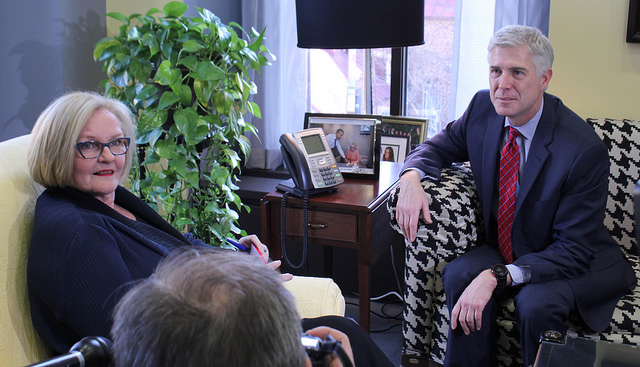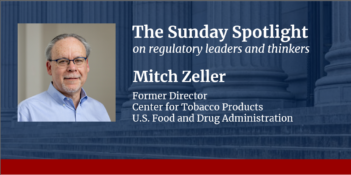
Scholar evaluates arguments for scaling back deference doctrines in light of renewed interest in reform.
Justice Neil Gorsuch’s criticism of courts’ practice of giving special weight to agency interpretations of law—also known as Chevron deference—was front and center during his confirmation hearings earlier this year. In a revealing opinion that he authored as a federal appellate judge, Justice Gorsuch wrote that such deference allows the federal bureaucracy “to swallow huge amounts of core judicial and legislative power…in a way that seems more than a little difficult to square with the Constitution.” And recently, Justice Gorsuch clearly signaled his intent to re-examine judicial deference to agencies in a case dealing with an agency’s interpretation of a contract.
But with Justice Gorsuch now on the U.S. Supreme Court, and congressional Republicans considering ways to constrain the administrative state, what are the best legal options for reforming Chevron?
A forthcoming article by Christopher J. Walker, a law professor at The Ohio State University Moritz College of Law, surveys recent arguments in favor of scaling back or eliminating judicial doctrines under which federal courts defer to agency interpretations. Walker disclaims any attempt to “break major new ground” in the debates over whether deference should be modified by the courts or which arguments for doing so are strongest. Rather, Walker aims in his article to “provide a literature review of sorts concerning the arguments that have been advanced in recent years to eliminate or narrow” the courts’ deference doctrines. Recognizing “a growing call to eliminate—or at least narrow—administrative law’s judicial deference doctrines regarding agency interpretations of law,” Walker assesses recent arguments against Chevron and a related doctrine known as Auer in an effort to help “judges, legislators, litigants, and scholars better focus arguments for reforming how federal courts review agency interpretations of law.”
The Chevron doctrine—named after the Supreme Court’s 1984 decision in Chevron v. Natural Resources Defense Council—provides that when litigants challenge agency decisions in court, judges must “defer to an agency’s interpretation of a statute the agency administers” whenever the law at issue is “ambiguous” and “the agency’s interpretation of the statutory ambiguity is reasonable.” Auer deference—which came from the Supreme Court’s 1997 decision in Auer v. Robbins—in turn provides that courts ordinarily defer to an agency’s interpretation of its own regulations unless an interpretation is “plainly erroneous or inconsistent with the regulation.”
The concerns about the Chevron and Auer doctrines, Walker explains, are generally about whether they endanger the separation of powers principles embodied in the U.S. Constitution. To their critics, Chevron and Auer entail “the dangerous consolidation of law-making and law-execution powers in” federal agencies. Those advocating for reconsideration of the Chevron and Auer doctrines in recent years include federal judges, legislators, and legal academics, Walker observes. Moreover, congressional Republicans recently introduced the Separation of Powers Restoration Act of 2017, which—if enacted—would require courts to interpret all statutes and regulations without deferring to agency interpretations.
Despite much criticism, Chevron and Auer still have many defenders who argue that courts should defer to agencies in certain situations. As the late Supreme Court Justice Antonin Scalia once explained, Chevron may have been justified initially by its faithfulness to the intent of Congress. According to Justice Scalia, in certain situations Congress may have intended—in using vague language in a law—to give agencies some discretion to resolve issues, and in those situations the only question the court needs to address is “whether the agency has acted within the scope of its discretion-i.e., whether its resolution of the ambiguity is reasonable.” Moreover, agencies may also have significant “expertise” in the field they are responsible for regulating, such that “their practical knowledge” may help them come up with the best answers to new problems.
Walker observes that arguments against Chevron deference typically fall into two categories: those involving concerns about Article III of the U.S. Constitution on the one hand, and those that concern Article I on the other.
Article III describes the organization and duties of the federal judiciary. Walker explains that Article III concerns about Chevron center on federal judges’ responsibility to “exercise independent judgment” in interpreting the law. Justice Clarence Thomas, for example, has argued that “Chevron deference precludes judges from exercising” independent judgment in determining the law because it forces them to favor an agency’s interpretation even if a judge believes there is a better interpretation of the law. Likewise, Columbia Law School professor Philip Hamburger has argued that “Chevron deference imbues the federal judiciary with institutional bias in favor of the most powerful parties,” federal agencies.
Article I of the Constitution sets forth the structure and authorities of Congress. Walker observes Chevron may also undermine Congress’ lawmaking power because “Chevron deference encourages members of Congress to delegate broad lawmaking power to federal agencies.” Moreover, granting deference to agency interpretations of statutes under Chevron creates “perverse incentives” that Office of Information and Regulatory Affairs Administrator Neomi Rao has asserted can lead to “collusion between members of Congress and administrative agencies” by “fracturing the collective Congress and empowering individual members.”
In addition to concerns about encroachment on the legislative and judicial branches, Walker says there are a “third set of potential arguments” that focus on Article II, which concerns the executive branch. Walker notes that his own recent research suggests that federal bureaucrats are “deeply involved” in the actual drafting of legislation—either to submit it to Congress on behalf of the administration or in providing drafting assistance to legislators. In his recent article in the University of Pennsylvania Law Review, Walker observes that “agencies often are substantially involved in drafting the legislation that ultimately delegates to the agencies the primary authority to interpret that legislation.”
In his article, Walker also evaluates arguments against Auer deference—a related doctrine that grants agencies deference for their interpretations of their own regulations. As with Chevron deference, a primary argument for constraining Auer deference, Walker observes, concerns the constitutionality of placing the lawmaking and law enforcement functions in the hands of a single agency. Another concern with Auer is that the doctrine creates “inappropriate incentives for agencies to draft vague regulations and interpret those regulations through less-formal means after the fact” so that the agency can then receive Auer deference.
Some legal scholars have also argued that Auer has become more deferential over time and should be reformed into a “less-deferential” standard, which would allow courts flexibility to consider many factors in evaluating agency interpretations of regulations, rather than a hard-and-fast rule that would often require courts to defer to agencies. Additionally, some scholars have argued that in applying Auer courts “should not accord any deference to agency interpretations advanced for the first time in private letters or other informal agency actions”—an issue that arose in Gloucester County School Board v. G.G., a case in which a federal appellate court deferred to the U.S. Department of Education’s interpretation of its own Title IX regulations concerning transgender bathroom use by students in public schools.
Although Walker suggests that it is unlikely that the Supreme Court will eliminate Chevron deference entirely, he says that the Court may nonetheless try to at least limit the doctrine. But in any case, Walker notes, whether “Auer or Chevron deference should be shelved is subject to considerable debate—a debate that will no doubt continue for years.”
Walker’s article is forthcoming in the Georgetown Journal of Law & Public Policy.
The photograph of Justice Gorsuch and Senator Claire McCaskill is used unaltered under a Creative Commons license.



